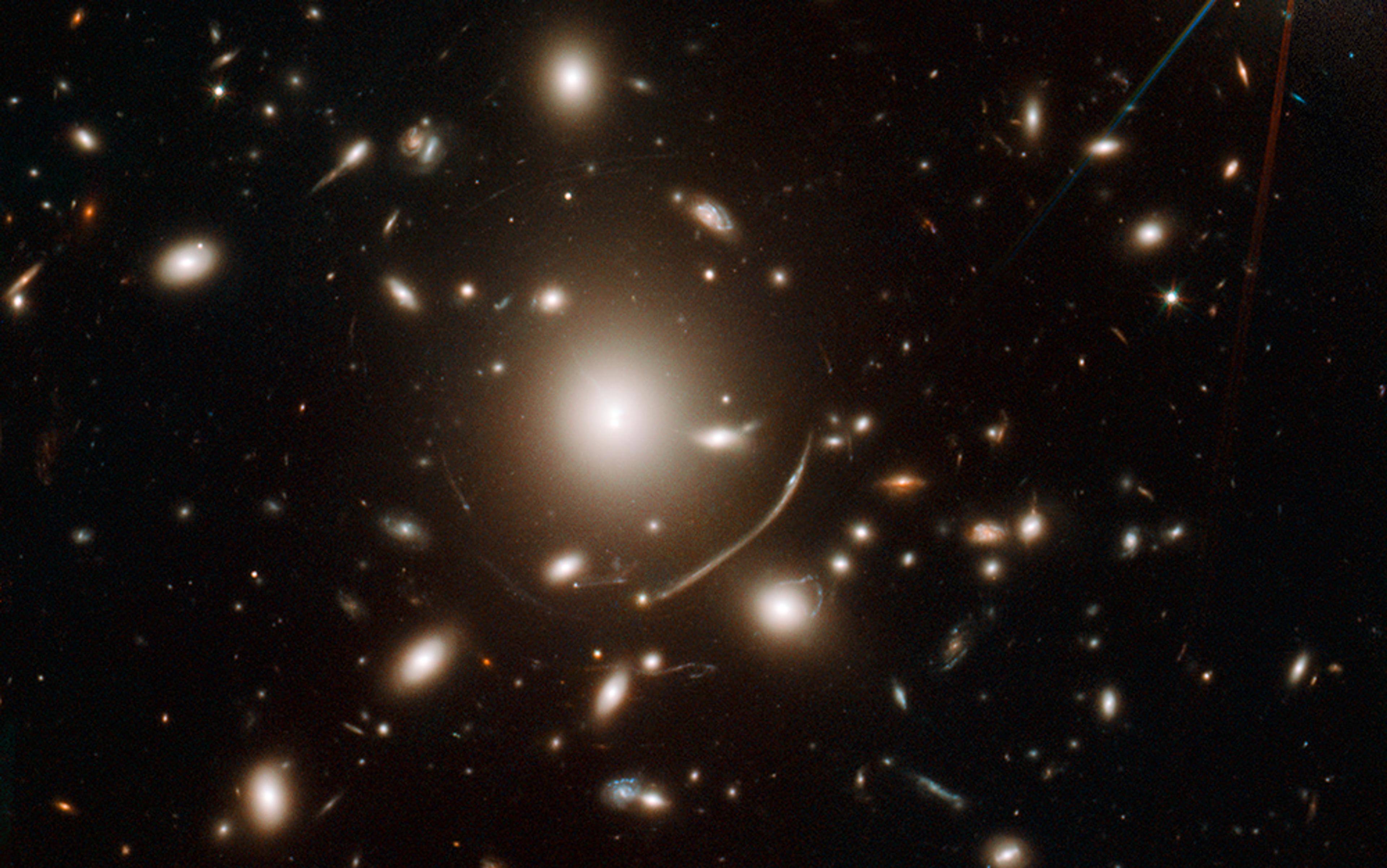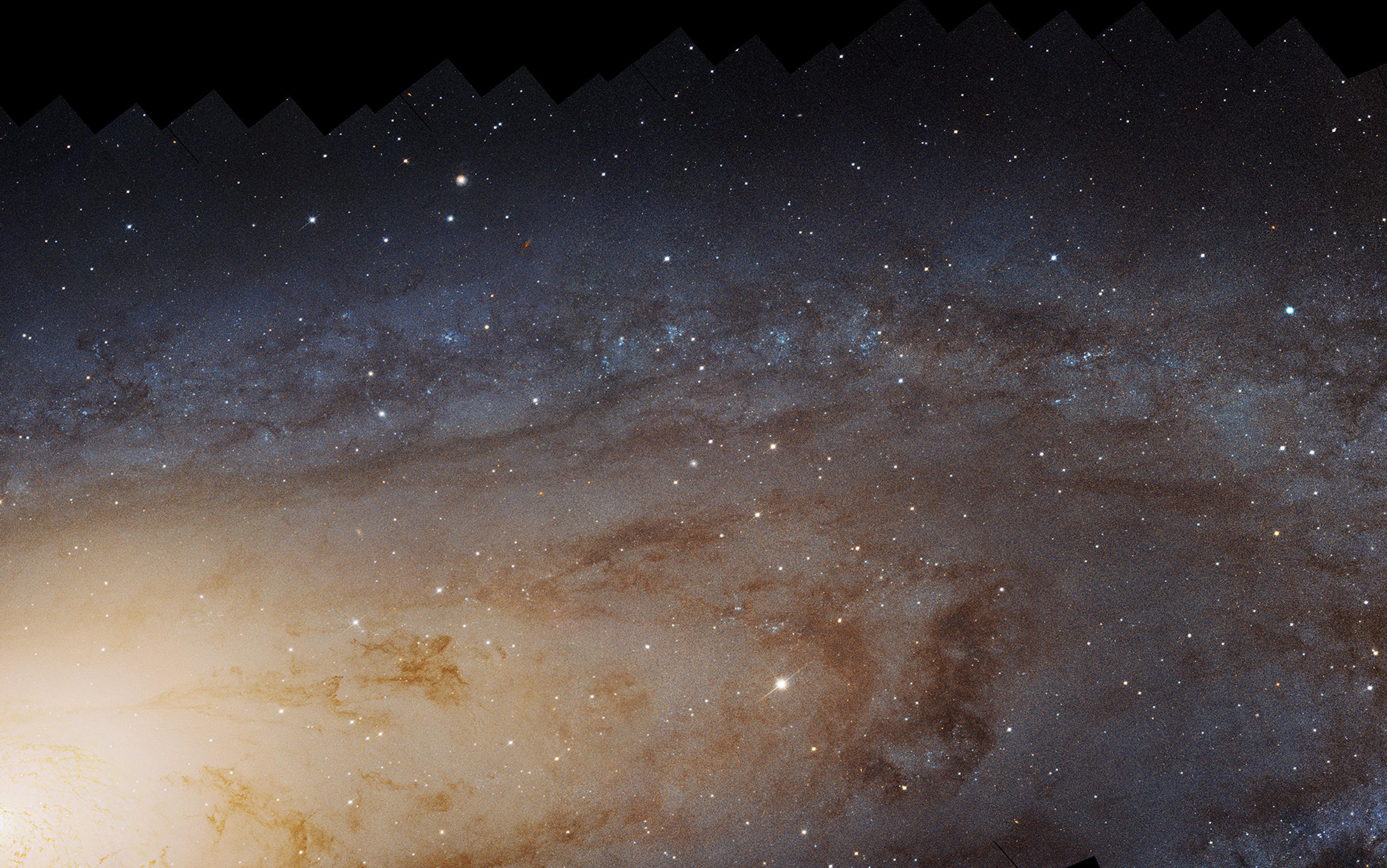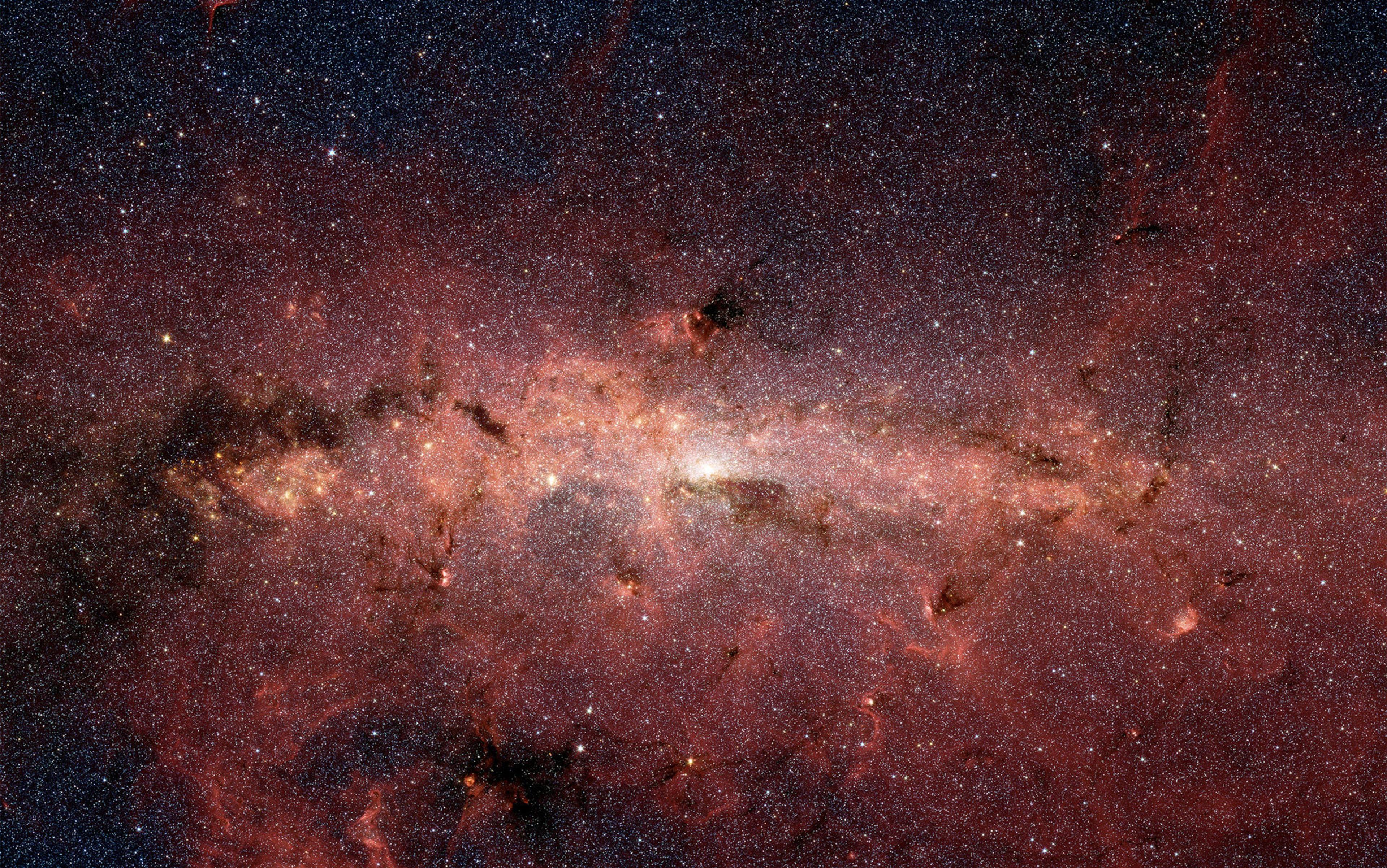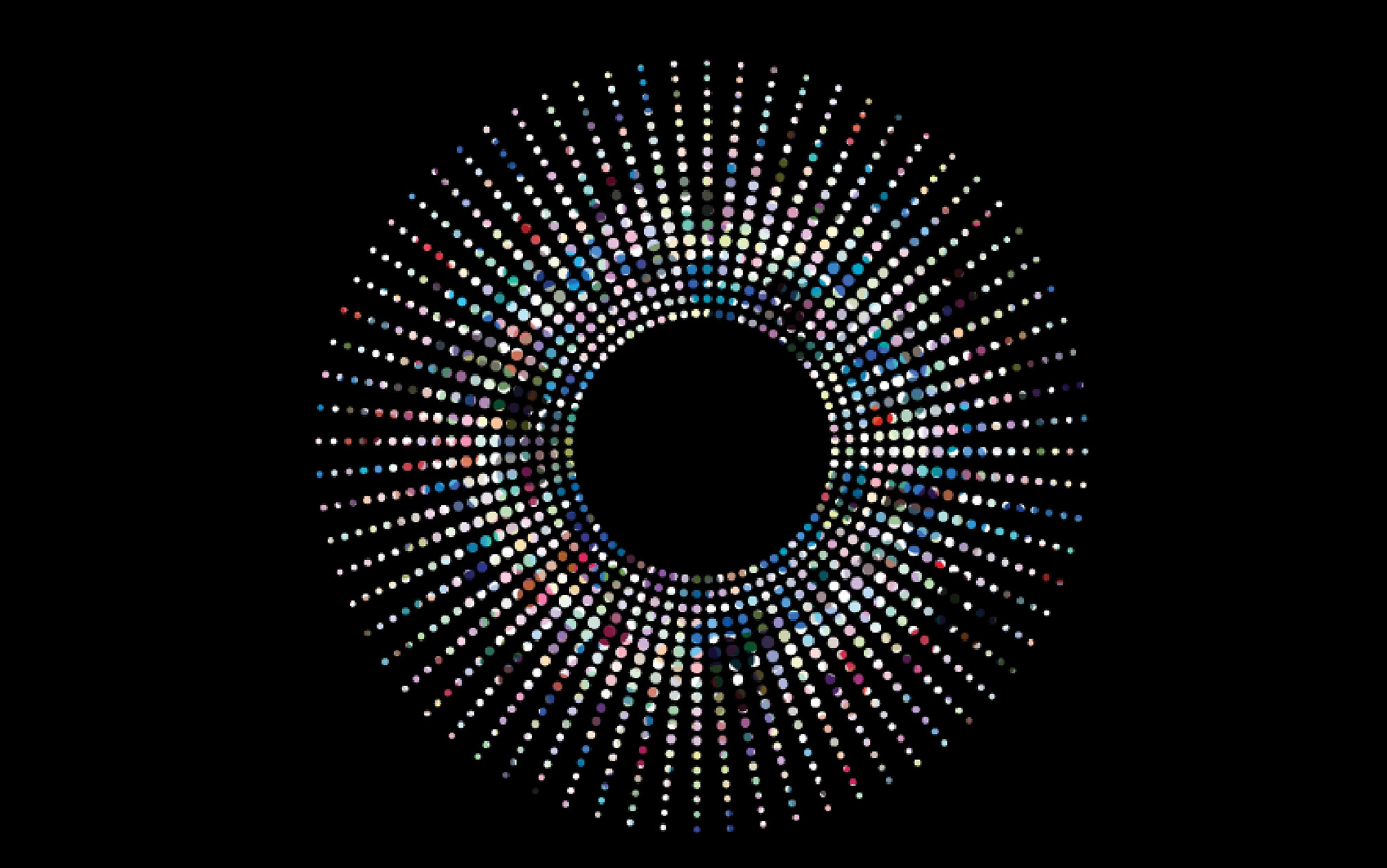Most of the matter in the Universe is invisible, composed of some substance that leaves no mark as it breezes through us – and through all of the detectors the scientists have created to catch it. But this dark matter might not consist of unseen particle clouds, as most theorists have assumed. Instead, it might be something even stranger: a superfluid that condensed to puddles billions of years ago, seeding the galaxies we observe today.
This new proposal has vast implications for cosmology and physics. Superfluid dark matter overcomes many of the theoretical problems with the particle clouds. It explains the long-running, increasingly frustrating failure to identify the individual constituents within these clouds. And it offers a concrete scientific path forward, yielding specific predictions that could soon be testable.
Superfluid dark matter has important conceptual implications as well. It suggests that the common picture of the Universe as a mass of individual particles bound together by forces – almost like a tinker toy model – misses much of the richness of nature. Most of the matter in the Universe might be utterly unlike the matter in your body: not composed of atoms, and not even built of particles as we normally understand them, but instead a coherent whole of vast extension.
‘For many years, people had a very simple model for dark matter: collisionless particles that don’t emit light,’ says Justin Khoury, a professor of theoretical physics at the University of Pennsylvania. ‘But in the last 20 years or so, as observations and [computer] simulations have improved, there are some tensions on galactic scales with this simple model.’ Collisionless dark-matter particles do not substantially interact with each other, and therefore do not settle down into compact structures equivalent to stars and planets. Since dark matter does not (by definition) emit light, the evidence for it comes from its gravitational effects: unseen material seems to have influenced the formation, rotation and motions of galaxies. On very large scales, collisionless dark matter generally matches up well with astronomical observations.
On smaller scales, however, this popular and widely used dark-matter model predicts that more material would clump in galactic centres than astronomers actually find, an issue known as the ‘cusp problem’. The model also results in too many satellite galaxies for the Milky Way, and it fails to explain why the ones we have lie almost on a plane. Finally, collisionless dark matter gives no hint as to why the brightness of spiral galaxies is correlated with their rotation velocity. The simple model, it seems, was too simple.
One possible explanation for these shortcomings is that physicists have missed an important astrophysical process in galaxy formation. But Khoury doesn’t think so. For him, the problems hint at something deeper. It isn’t only that the model of collisionless, cold dark matter has its difficulties fitting some data, it’s that an entirely different model does better with exactly those observations with which the standard model has difficulties. Instead of invoking new, undiscovered particles, this different model posits that the evidence for dark matter is instead due to a modification of gravity. There is no direct way to measure how gravity behaves over distances of thousands or millions of light years. Subtle effects that cannot be detected on Earth could be powerful enough to have a significant influence on entire galaxies.
The modification of gravity is stunningly successful in some cases, but has problems elsewhere. On the one hand, it fits the rotations of galaxies with remarkably little effort and explains why their brightness-velocity relations all seem alike: modified gravity allows less variation from galaxy to galaxy than does the formation of particle clouds, which could all be different. On the other hand, modified gravity struggles with the observational data for distances much larger or smaller than the size of a typical galaxy. On those scales, it’s the cold dark matter model that works better.
It is notoriously difficult to change anything about Albert Einstein’s theory of gravity without ruining it altogether, so most physicists have opted for the safer alternative of particle dark matter. For them, conjecturing new particles is a well-trodden way to solve problems, and the mathematics is familiar territory. But Khoury doesn’t want to pick a side. He wants the best of both, to make the best possible fit with the real Universe.
‘Traditionally, people have tried to address the galactic-scale problems by modifying gravity; that’s been the alternative to dark matter,’ Khoury says. ‘For some reasons, maybe sociologically, these two approaches have been considered exclusive: either you’re in the modified gravity camp, or you’re in the particle dark matter camp. But why couldn’t it be both? Of course, Occam’s razor would say it’s less compelling. So the approach we’ve taken is that both phenomena, modified gravity and particle dark matter, could just be aspects of the same theory.’
Evidence for dark matter has been building since its discovery by the Swiss astronomer Fritz Zwicky more than 80 years ago. In 1933, Zwicky had his eyes on the 100-inch Hooker telescope at Mount Wilson Observatory in California, and aimed at the Coma Cluster. The Coma Cluster is a swarm of about 1,000 galaxies bound together by the pull of their own gravitational field. In such a bound system, the velocities of the constituents – in this case, galaxies – depend on the total mass that is bound. Zwicky noted that the galaxies were moving much more quickly than the visible mass combined could account for, and he speculated that the cluster must contain unseen matter. He called it Dunkle Materie, German for ‘dark matter’.
Physicists might have dismissed this case as a peculiarity. But it became apparent that Zwicky’s observation was the rule rather than the exception when the American astronomer Vera Rubin, starting in the 1960s, studied the rotation of spiral galaxies. The velocity of stars on orbits far away from a galaxy’s centre depends on the total mass (and hence gravitational pull) of the bound system, in this case the mass of the galaxy. Rubin’s measurements showed that dozens of galaxies were rotating more rapidly than only the visible matter had led her to expect. Ever since Rubin’s observations brought dark matter to the limelight, it has ranked top on the list of physicists’ unsolved problems.
Instead of solving the mystery, the direct-detection experiments have only deepened it
With steadily improving telescope technology, the observational support for dark matter has accumulated and become more precise. Physicists are now able to perceive the subtle distortions caused by the gravitational warping of space-time near galaxy clusters. This distortion, known as weak gravitational lensing, slightly deforms the images of more distant stellar objects; their light bends around the cluster, whose gravity acts as a lens. From the strength of this effect, the cluster’s total mass can be calculated, demonstrating the presence of dark matter. By this method, physicists have even generated maps of the distribution of dark matter. Combining this with other lines of evidence, they have deduced that 85 per cent of the matter in the Universe must be dark.
With more data, physicists could also exclude the idea that dark matter consists of unseen clumps of ordinary atoms, like the ones Earth is made of (technically known as baryonic matter). This normal matter interacts too strongly with itself; it would not produce the observed distribution of dark matter. Dark matter also cannot be made of stars that collapsed to black holes or other very dim stellar objects. If that were so, these objects would have to vastly outnumber the stars in our galaxy and cause intense gravitational distortions that could be readily observed. Nor can dark matter be made of other known particles, such as the weakly interacting neutrinos that are emitted abundantly by stars. Neutrinos would not clump enough to create the observed galactic structures.
Therefore, to explain what makes up dark matter, physicists instead had to theorise about new, so far undetected, particles. The most widely used ones fall into two broad classes: weakly interacting massive particles (WIMPs) and much lighter axions, though there is no shortage of more complex hypotheses that combine various types of particles. But all attempts to detect any of these particles directly, rather than inferring their presence from their gravitational pull, have so far been unsuccessful. Instead of solving the mystery, the direct-detection experiments have only deepened it.
‘It is impossible to be interested in cosmology today without being interested in dark matter,’ says Stefano Liberati, a physics professor at the International School for Advanced Studies (SISSA) in Italy. Liberati and his collaborators have independently worked out an explanation for dark matter very similar to Khoury’s. When Liberati first learned how successful modifications of gravity are on galactic scales where cold dark matter models fall short, he immediately tried to think of ways to combine the two. ‘It made me think: maybe dark matter at small scales makes a type of phase transition,’ he says. ‘Maybe it transforms into a type of fluid, in particular a superfluid. If it forms a condensate at the scale of galaxies, this really solves a lot of problems.’
Superfluids do not exist in daily human experience, but they are well-known to physicists. They are analogous to superconductors, a class of materials that moves electricity without resistance. When cooled to temperatures near absolute zero, helium likewise starts flowing without resistance. It will creep through the tiniest pores, and even slide out of trays by moving up walls. Such ‘superfluid’ behaviour isn’t specific to helium; it is a phase of matter that, at low enough temperatures, can be reached by other particles too. First predicted in 1924 by Einstein and the Indian physicist Satyendra Bose, this whole class of ultra-cold superfluids is now known as Bose-Einstein condensates. Liberati realised that dark matter might have a superfluid state as well.
Bose-Einstein condensates are best understood as a mixture of two components: one that is superfluid and one that isn’t. The two components behave very differently. The superfluid one exhibits long-range quantum effects, no viscosity, and unexpected correlations over large distance scales; it is as if it was made of much larger particles than its actual tiny constituents. The other normal component behaves like the fluids we are used to; it sticks to containers and to itself – it has a viscosity. The ratio between the two components depends on the condensate’s temperature: the higher the temperature, the more dominant the normal component.
We are used to thinking that quantum physics dominates only the microscopic realm. But the more physicists have learned about quantum theory, the more it has become clear that this isn’t so. Bose-Einstein condensates are one of the best-studied substances that allow quantum effects to spread widely through a medium. In theory, quantum behaviour can span arbitrarily large distances, provided it isn’t disturbed too much.
In a warm and noisy environment such as Earth, fragile quantum effects are quickly destroyed. That is why we don’t normally observe the stranger aspects of quantum physics, such as the ability of particles to behave like waves. But initiate quantum behaviour in a cool, quiet place and it will last. A cool, quiet place like, for example, outer space. There, quantum effects might stretch across vast distances.
Superfluid dark matter might also overcome the psychological challenge of modified gravity: most astrophysicists dislike it
If dark matter were a Bose-Einstein condensate – one with quantum effects spreading throughout whole galaxies – this state would naturally account for two different behavioural modes of dark matter. Within galaxies themselves, most of the dark matter would be in the superfluid phase. But across galaxy clusters that include much intergalactic space, most of the dark matter would be in the normal phase, giving rise to a different behaviour. According to Khoury and collaborators, it is possible to explain the observed effects of dark matter with a simple model of a Bose-Einstein condensate, one that has only a few open parameters (that is, just a few properties that must have the right attributes to make the model work).
The idea that dark matter might be a Bose-Einstein condensate had circled through the astrophysics community before, but this version is different. What makes Khoury’s new idea so compelling is that he claims the superfluid dark matter could also mimic modified gravity: it achieves his goal of combining the best of both models. Gravity, it turns out, must not actually be modified to get the results seen in the modified gravity theories. A coherent superfluid can give rise to the same equations, and the same behaviours. In this way, Khoury’s model combines the advantages of both cold dark matter and modified gravity, without the disadvantages of either.
Superfluid dark matter might also overcome the biggest challenge for modified gravity: most astrophysicists dislike it. Many of these researchers have a background in particle physics, and the equations of modified gravity are nothing like what they are used to. To the particle physicist, they look unappealing, unnatural even. They seem made up merely to fit the bill. But superfluid dark matter offers a different, perhaps more natural way of coming at the equations.
According to Khoury, the equations for superfluid dark matter don’t belong to the realm of elementary particle physics. They emerge from theory in condensed matter physics, where they describe not the fundamental particles, but their emergent long-range behaviour. In Khoury’s model, the equations that appear in modified gravity are not those of the individual particles. Instead, they are a description of the particles’ collective interplay. Such equations are unfamiliar to many particle physicists, which is why the relation between superfluidity and modified gravity remained unnoticed for so long. Unlike the equations of modified gravity, however, the equations describing superfluids already have a strong theoretical foundation – just in condensed-matter physics.
That Khoury noticed the connection was serendipity. He came across literature in condensed matter physics that used equations very similar to the ones he knew from modified gravity: ‘And then the rest just fit in,’ he says. ‘I thought all of this just formed a nice picture to unify the two phenomena.’
Returning to the observational evidence for dark matter, Khoury’s superfluid approach could solve many problems with the existing models. To begin with, the superfluid prevents dark matter from clumping too much in galactic centres, eliminating the spurious ‘cusp’, because the superfluid phase evens out any strong density fluctuations. ‘A superfluid will have a coherence length [a distance over which all of the matter is in the same state],’ Liberati says. ‘You already know that you can’t have a cusp.’
The superfluid generates patterns of attraction identical to those of the equations of modified gravity, so it can reproduce the observed regularity of galactic rotation curves. However, unlike modified gravity, it behaves this way only in the temperature range in which the superfluid component is dominant. On the larger scale of galactic clusters, the dark matter gets too agitated (that is, too hot) and loses its superfluid properties. In this way, superfluid dark matter could have seeded the formation of visible galaxies while, in its non-superfluid phase, it would match up with the observed structure of clusters.
‘When I was a student, I used to wake up every 30 nights from a dream about modified gravity’
Khoury’s approach explains why astronomers do not see any evidence of modified gravity within the solar system. ‘The Sun itself creates such a huge gravitational field that it would locally destroy the superfluid’s coherence,’ he says. ‘In the vicinity of the solar system, you shouldn’t think in terms of a coherent superfluid. The Sun acts like an impurity. It’s like there’s dirt in the fluid.’
Finally, the superfluid model explains why physicists have not been able to find dark matter particles. Starting in the 1980s, dozens of different experiments have looked for direct evidence of such particles. The experiments generally use large, well-shielded tanks of different materials that might, on rare occasions, interact with a dark matter particle and produce an observable signal. Despite a wide variety of techniques and materials, using detectors that are carefully shielded and hidden away in underground mines to filter out false signals, no conclusive evidence of dark matter has been found.
With that lack of detection, the once-derided idea that dark matter might be something other than just another type of particle is becoming more compelling. ‘When I was a student, I used to wake up every 30 nights from a dream about modified gravity,’ says Nima Arkani-Hamed, professor of theoretical physics at Princeton. ‘Then it was once every 300 nights. Now it’s once every 100. It’s on the rebound.’
If dark matter is a superfluid, the particles it is made of must be lightweight, much lighter than the hypothetical dark particles that have been the targets of most of the searches. The superfluid’s constituents are probably too slight to show up in the experiments currently running.
A better and unique prediction of Khoury’s model is that a superfluid’s quantum behaviour should leave a telltale pattern in galactic collisions. When the dark matter condensate from one galaxy runs into that of another, the collision would create interference patterns – ripples in the distribution of matter and gravity, which would affect how the galaxies settle. Superfluid dark matter also makes predictions for the friction between the dark matter components within galaxy clusters; such friction would again produce distinctive patterns of gravitational attraction. Observations of gravitational lensing could detect these fingerprints of superfluid dark matter, provided we know exactly what we’re looking for.
To quantify the predictions, computer simulations are necessary. Khoury is currently working on just such a project with researchers at the University of Oxford. Simulations should also show whether the expected number of satellite galaxies from superfluid dark matter agrees better with observations than do the predictions of the current models.
Amanda Weltman, a cosmologist at the University of Cape Town, who works on dark matter but was not involved in this research, finds the new model ‘very interesting and creative’. But she says she will reserve judgment until she sees some experimental confirmation, some signature that would distinctively support superfluids: ‘Such an observation would then lend real weight to their ideas.’ If the supercomputer simulations are a success, Khoury might be able to produce that kind of evidence. Then we will have to get used to an even stranger view of the Universe – one filled not just with dark matter, but with frictionless fluids swirling around all of the bright galaxies.
Arkani-Hamed is more skeptical, not quite ready to give up on cold dark matter. ‘But if they don’t discover WIMPs in the next set of experiments, they’re not going to see them for 20 years,’ he says. The time is ripe, he thinks, to take a fresh look at models built around unconventional particles or modified theories of gravity. Or a model that combines the best of both dark worlds.






